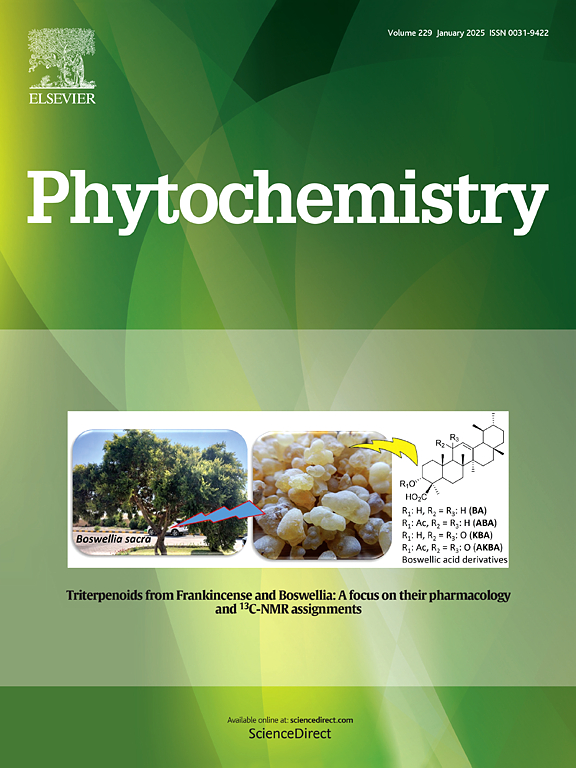从丹参中提取的抗炎噁唑、硝基和六氢吡咯并[2,1-b]噁唑-含阿比坦二萜生物碱。
IF 3.2
2区 生物学
Q2 BIOCHEMISTRY & MOLECULAR BIOLOGY
引用次数: 0
摘要
从丹参的根中分离出了九种未蜕变的双乙烷二萜生物碱(DAs),即丹酚胺 G-H (1-2)、异丹酚胺 G-J (3-6)和丹酚胺 A-C (7-9)。通过广泛的光谱分析(包括一维和二维核磁共振以及 HRESIMS),结合计算 ECD 法和单晶 X 射线衍射分析,阐明了它们的化学结构,包括绝对构型。其中,化合物 1-6 是不常见的具有噁唑环的 20-去甲或 19,20-双去甲阿比坦 DA。化合物 7-8 是首次从植物中分离出带有硝基的 DAs。值得注意的是,化合物 9 具有一个罕见的六氢吡咯并[2,1-b]恶唑单元,该单元融合在阿比特烷骨架的环 B 中。生物活性分析表明,化合物 3 具有显著的抗炎活性,能以剂量依赖的方式降低 LPS 诱导的 RAW264.7 细胞中 IL-1β、IL-6 和 TNF-α 的基因表达。本文章由计算机程序翻译,如有差异,请以英文原文为准。
![Anti-inflammatory oxazole-, nitro- and hexahydropyrrolo[2,1-b]oxazole-containing abietane diterpenoid alkaloids from Salvia miltiorrhiza](https://img.booksci.cn/booksciimg/2024-10/99294521231760026256.jpg)
Anti-inflammatory oxazole-, nitro- and hexahydropyrrolo[2,1-b]oxazole-containing abietane diterpenoid alkaloids from Salvia miltiorrhiza
Nine undescibed abietane diterpenoid alkaloids (DAs), salviamines G‒H (1–2), isosalviamines G‒J (3–6), and miltiorramines A‒C (7–9) were isolated from the roots of Salvia miltiorrhiza. Their chemical structures including absolute configurations were elucidated by extensive spectroscopic analysis (including 1D and 2D NMR, and HRESIMS), combined with the calculated ECD method and single-crystal X-ray diffraction analysis. Among them, compounds 1–6 are unusual 20-nor- or 19,20-bisnor-abietane DAs with an oxazole ring. Compounds 7–8 are the first examples of DAs with a nitro group isolated from plant sources. Notably, compound 9 possesses a rare hexahydropyrrolo[2,1-b]oxazole unit that is fused in the ring B of the abietane skeleton. Bioactivity assay indicated that compound 3 showed significant anti-inflammatory activity by decreasing the gene expressions of IL-1β, IL-6, and TNF-α in LPS-induced RAW264.7 cells in a dose-dependent manner.
求助全文
通过发布文献求助,成功后即可免费获取论文全文。
去求助
来源期刊

Phytochemistry
生物-植物科学
CiteScore
6.40
自引率
7.90%
发文量
443
审稿时长
39 days
期刊介绍:
Phytochemistry is a leading international journal publishing studies of plant chemistry, biochemistry, molecular biology and genetics, structure and bioactivities of phytochemicals, including ''-omics'' and bioinformatics/computational biology approaches. Phytochemistry is a primary source for papers dealing with phytochemicals, especially reports concerning their biosynthesis, regulation, and biological properties both in planta and as bioactive principles. Articles are published online as soon as possible as Articles-in-Press and in 12 volumes per year. Occasional topic-focussed special issues are published composed of papers from invited authors.
 求助内容:
求助内容: 应助结果提醒方式:
应助结果提醒方式:


